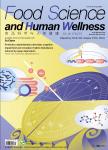Exploring the material basis and mechanism of Moringa oleifera in alleviating slow transit constipation based on network pharmacology and animal models
作者机构:College of Food Science and Technology Yunnan Agricultural University Yunnan Key Laboratory of Precision Nutrition and Personalized Food Manufacturing Yunnan Agricultural University Department of Science and Technology Yunnan Agricultural University College of Veterinary Medicine Yunnan Agricultural University Engineering Research Center of Development and Utilization of Food and Drug Homologous Resources Ministry of Education Yunnan Agricultural University
出 版 物:《Food Science and Human Wellness》 (食品科学与人类健康(英文))
年 卷 期:2024年
核心收录:
学科分类:0832[工学-食品科学与工程(可授工学、农学学位)] 08[工学] 083201[工学-食品科学]
摘 要:Moringa oleifera(M. oleifera) have laxative effects, but their active compositions and mechanisms are not very clear thus far. To this end, we systematically explored the active components and mechanism of M. oleifera leaves in relieving constipation by using the slow transit constipation (STC) mouse model and network pharmacology. The results of animal experiments showed that M. oleifera aqueous extract (MOA) had good laxative activity, and its 70% alcohol soluble part (ASP) also showed significant laxative activity(P 0.01). Network pharmacological prediction results suggested that L-phenylalanine (Phe) was the key compound of ASP, and it might relieve constipation through tachykinin receptor 1 (TACR1) and three kinds of adrenergic receptors, including alpha-1a (ADRA1A), alpha-2a (ADRA2A), and alpha-2b (ADRA2B). Further animal experiment results showed that Phe significantly promoted gastrointestinal motility. Phe may relieve STC by enhancing the release of substance P (SP) and upregulating the mRNA expression of TACR1 in the ileum. Importantly, Phe may also promote intestinal movement by downregulating ADRA2A and ADRA2B and upregulating calmodulin and the mRNA and protein expression of myosin light chain 9 (MYL9) in the ileum, thereby activating the GPCR-MLC signaling pathway. These results lay a foundation for the application of M. oleifera and Phe in constipation.



